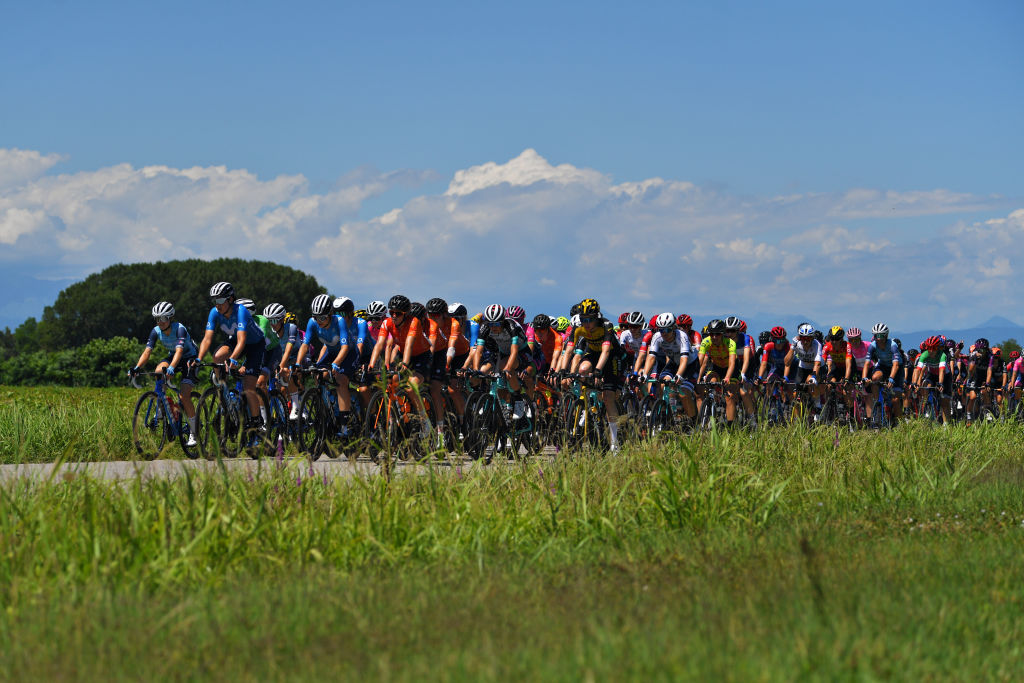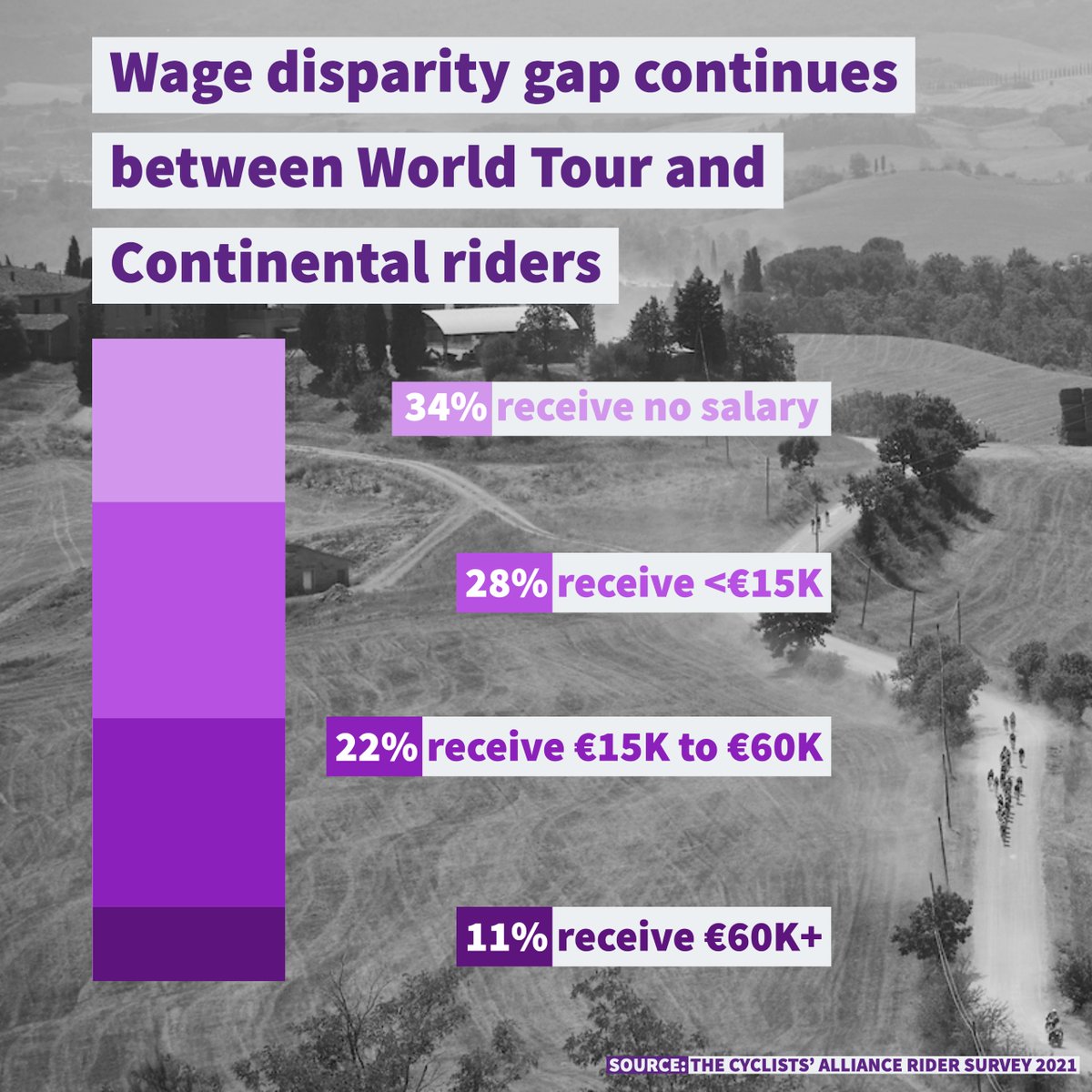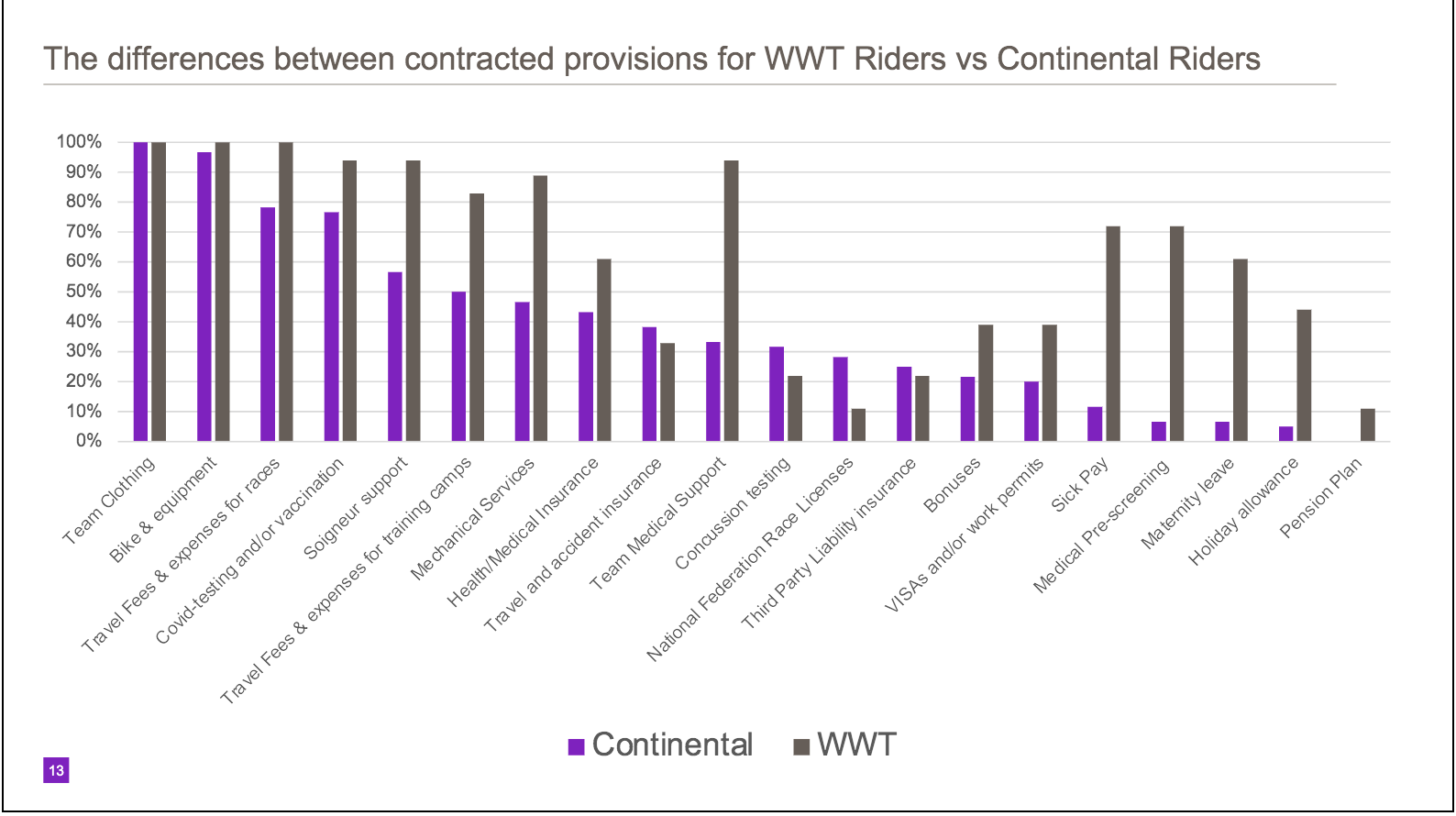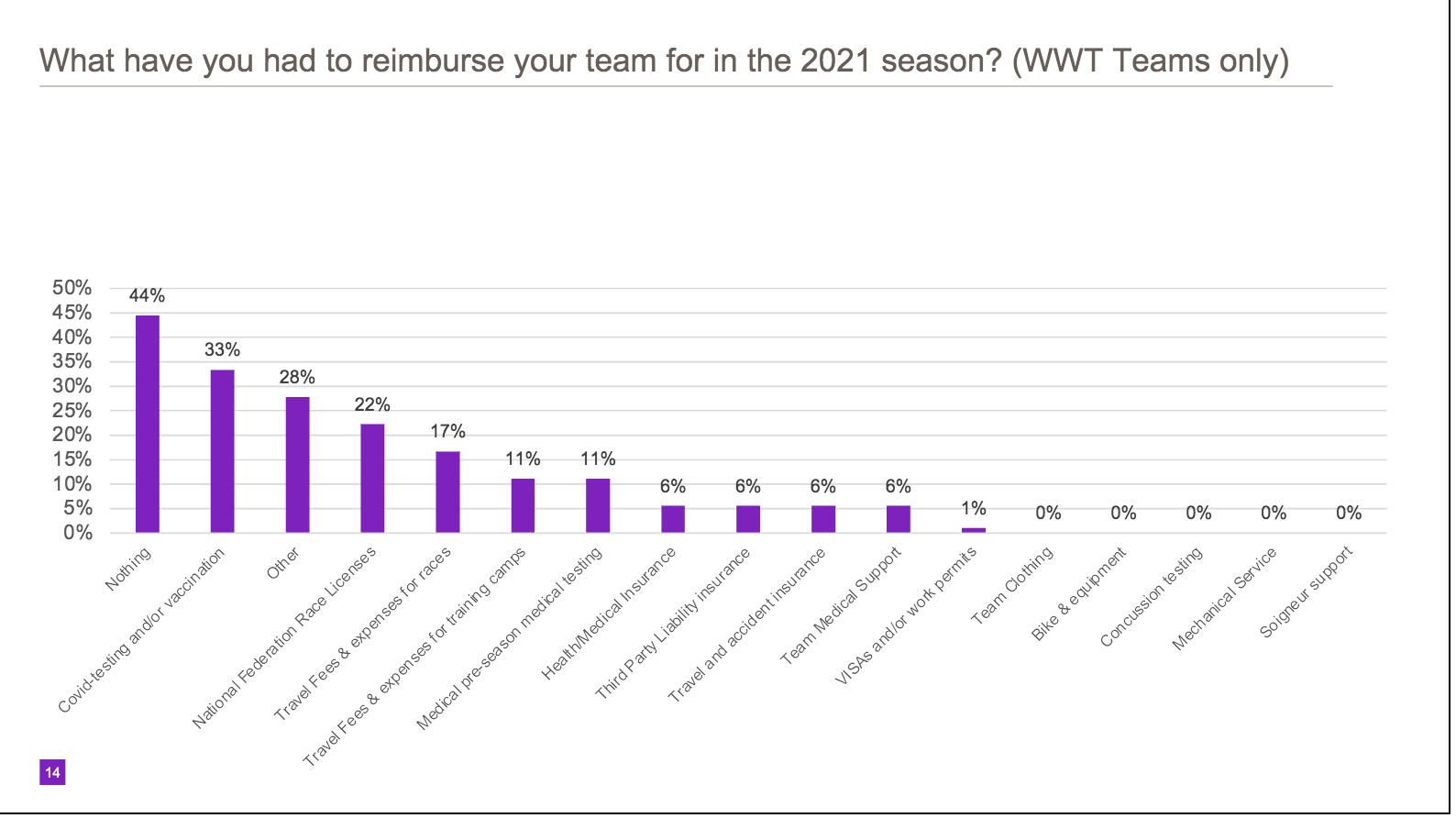Number of women cyclists earning no salary continues to rise, reaches 34 per cent
The Cyclists’ Alliance annual survey reveals increase in wage gap in women’s peloton, less medical support and more second jobs for riders on Continental teams

The Cyclists’ Alliance (TCA) has published its annual survey, revealing a growing wage disparity gap between the two tiers of teams, Women’s WorldTeams and Continental Teams. The survey revealed that the number of women in the peloton that are not paid a salary as part of second-tier team contracts has increased from 17 per cent in 2018 to 34 per cent in 2021.
The results are based on 97 professional female cyclists who participated in TCA’s annual survey that covered key areas: working conditions, legal and ethics and team culture. The association also noted that the same riders did not answer the survey year-on-year, but a similar number of riders completed the survey, which is approximately 10 per cent of the peloton.
TCA have only released the findings from the working conditions portion of the survey, but also plan to analyse and publish its findings for the other two sections –legal and ethics and team culture – in the coming weeks.
There are currently nine Women’s WorldTeams - Alé BTC Ljubljana, Canyon-SRAM, FDJ Nouvelle-Aquitaine Futuroscope, Liv Racing, Movistar Team Women, Team BikeExchange, Team DSM, Team SD Worx and Trek-Segafredo, and all top-tier teams are required to pay a minimum salary of €20,000 (employed) in 2021. These top-tier teams employ 160 riders.
However, there are 49 second-tier Continental Teams that contract 779 female athletes racing on the international calendar, and many of these teams compete in the Women's WorldTour events. Second-tier teams are not required to pay a minimum wage to their contracted athletes, and although some do, many do not.
The working conditions section of the TCA’s annual survey was divided into five main groups that covered rider salaries, contractual inclusions, rider reimbursements, second jobs and studying, and the impacts of COVID-19.
When it came to salaries, 86 per cent of riders who responded to the survey felt that the salaries provided in women’s cycling were too low compared to the level of commitment required of them as per their contracts.
Get The Leadout Newsletter
The latest race content, interviews, features, reviews and expert buying guides, direct to your inbox!
Perhaps the biggest finding was that the number of riders earning no salary has risen from 17 per cent in 2018 to 34 per cent in 2021.

The salary section of the survey also found that because there is no minimum salary requirement for second-tier teams, the wage disparity gap between Women’s WorldTeams riders and Continental riders has widened.
According to the survey, while 34 per cent of athletes receive no salary, 28 per cent received under €15,000, 22 per cent earned between €15,000 and €60,000, and 11 per cent earned €60,000 or more.
The UCI revealed that the average salary of athletes contracted with Women's WorldTeams has increased by 25 per cent in the one year following the implementation of a minimum wage required for top-tier teams, according to a report by an external auditing firm EY Lausanne, that was appointed by the UCI as part of the teams' registration for the 2020 and 2021 seasons. Its report also showed that the average budget of Women’s WorldTeams increased by 22 per cent between 2020 and 2021.
The UCI stated, at the time it released that survey, that the creation of a minimum salary was closing the gap between the average salaries paid to Women’s WorldTeams riders and members of the men’s UCI ProTeams, reducing the gap from 67.53 per cent to 44.21 per cent this year.
Part of that gap reduction was attributed to Trek-Segafredo’s and Team BikeExchange’s decision to raise the minimum salary of riders on its Women’s WorldTour squads to match the rate mandated for the top-tier WorldTour riders on its men’s squad – effectively doubling their women's minimum wage from €20,000 to €40,045.
The EY Lausanne audit report, however, did not include the second-tier teams and there was no information released by the UCI about their salary ranges or statistics.
Riders who participated in the recent TCA annual survey indicated that areas they thought were a priority for the association to assist with through its advocacy were for all riders competing in the peloton earn a minimum salary and for increased live television coverage of women’s races.
"This trend demonstrates that wage disparity is growing between the highest and lowest paid riders in the peloton. We will continue to ask the UCI to audit and publish Continental rider salaries (like they do for WWT), to implement minimum salaries and to implement a ProTeam status," TCA stated.
Contracts and Medical

The level of professionalism among the top-tier Women’s WorldTeams has improved, according to the survey.
Outside of riders being paid a minimum salary, teams must also provide social insurances and benefits such as maternity leave, and they must have a multi-year sponsorship guarantee, which has allowed teams to offer their riders multi-year contracts with more stability.
TCA annual survey revealed, however, that riders contracted with Continental teams have not experienced the same increase in the level of professionalism.
TCA highlighted medical support as just one example were a discrepancy is large, with 94 per cent of riders contracted with top-tier teams receiving medical support in their contracts while only 33 per cent of riders on Continental teams benefit from this support.
As of next season, only Women’s WorldTeams will be required to employ a chief medical officer.
The UCI confirmed to Cyclingnews that the importance of medical staff is part of the strategy to professionalize women's cycling and that the requirements for compulsory team staff for UCI Women’s WorldTeams are planned to increase according to article 2.13.210 in 2021 and 2022.
In addition, implementation of the Organisational Criterion from 2022, which was postponed a year due to the pandemic, will include several points related to the medical field, especially under the section of Care; the team must employ one doctor responsible for organising medical care (the "head doctor"); each rider must have a medical consultant (doctor) identified by the team whether or not this individual is employed by the team; and a team must have internal medical regulations that set out the methods by which riders can seek medical assistance and access medical data.
The UCI stated that at the Continental level, however, the smallest women’s and men’s teams would not have a full-time team doctor or direct access to a doctor.
"At the level of the UCI Continental Teams, we have the same requirements for men and women, for example, a check-up must be carried out in accordance with the registration guide, but there is no reference doctor for the time being. This is something we have been looking at more closely since COVID-19, to see how we could develop this aspect further," stated the UCI.
Second jobs
TCA found that 39 per cent of riders who took its survey work a second job while under contract to race. Twenty-four per cent of those are working part-time (less than 20 hours a week) and 15 per cent of those are working more than 20 hours a week.
Of those riders working more than 20 hours per week, 67 per cent do not receive a salary from their cycling team, as part of their contract, and 14 per cent receive less than €5,000.
"Riders are balancing work with training and racing commitments to support themselves financially," stated the TCA.
In addition, 38 per cent of riders who participated are currently studying while also racing under a contract, in either high school, university or other vocational courses.
In a recent article, Racing below the breadline: The women’s cycling omertà, Cyclingnews spoke with Doris Schweizer, a four-time Swiss national champion who, like so many pro riders, works an additional part-time job at McDonald’s to pay the bills.
In addition, Cecile Uttrup Ludwig spent the first part of her cycling career working a second job in a supermarket. She is now paid a salary as part of the top-tier team FDJ Nouvelle-Aquitaine Futuroscope and told Cyclingnews that it made a big difference in her performance and, with more other riders also in a similar situation, to the overall level of strength in the women’s peloton in 2021.
"Back in the day, I was standing up working at a supermarket and that's not super good recovery," Uttrup Ludwig told Cyclingnews. "[Women] can now focus 100 per cent on cycling and it shows that the level is super good and increasing every year. When the level increases all the teams play a bigger role in the races."
COVID-19 affects on riders and teams

The 2020 season was shut down from March through July due to the health risks surrounding the COVID-19 global pandemic and those impacts have continued into the 2021 season, for both riders and teams.
TCA’s survey revealed that, overall, riders have been impacted less this year compared to last year. However, riders contracted with Continental teams are being negatively impacted more than riders on WorldTeams.
In 2021, only five per cent of riders contracted with top-tier teams had their salary reduced and only one per cent of riders on Continental teams lost their salary entirely due to the COVID-19 pandemic, a large improvement compared to the 29 per cent of riders who experienced a salary reduction last year.
However, seven per cent of riders contracted with Continental road teams were unable to secure a contract with a team for 2021 and stated that COVID-19 was the primary reason.
In addition, 20 per cent of riders on Continental teams had to cover the costs of their own COVID-19 testing to travel to races, while 94 per cent of WorldTeams riders stated that all COVID-19 testing was included and covered by their employment contract.
In 2020, the revised racing calendar, a replacement for plans that were halted due to the COVID-19 coronavirus pandemic last spring, affected riders, teams and event organisers. At the end of the season, the UCI drew positive conclusions from its protocols and for making it through the truncated season despite the unprecedented health risks linked to a global pandemic.
However, a COVID-specific survey from TCA taken last year in September, revealed concerns among riders, particularly from lower-budget and Continental women’s teams, who felt that the protocols were difficult to maintain in women’s cycling.
This survey was conducted midway through the shortened calendar, and used to gather information regarding the needs and fears of the athletes racing in women’s road, track, mountain biking and cyclo-cross, but the majority of the responses come from female road athletes.
The results of the COVID-specific survey suggest the need for a more fair and realistic system, standardised level of care across all teams, better organisation and more education on how to execute the health protocols.
It also suggested the provision of a team doctor and a subsidy could help smaller Continental teams and events cope with the logistics and costs of implementing health protocols to better ensure safety for everyone at the races in future.
In addition, the costs of implementing the COVID-19 protocols at races hit second-tier teams the hardest. The amount a team spent on implementing the COVID-19 protocols varied, depending on how many races they participated in and where the team was located.
Norwegian-based team Hitec Products competed in a partial calendar last year that included six one-day events and one three-day stage race, whereby the cost involved in implementing the health protocols was approximately €11,000. The costs for COVID-19 PCR tests amounted to €7,000, additional travel costs were €2,000 and other minor costs due to COVID-19 were €2,000, the team’s manager Karl Lima told Cyclingnews.
Lima confirmed, last year, that Hitec Products had a team doctor that worked out of Stavanger and rarely travelled with the team.
"The amount was manageable down to the fact that we saved some cash in the lockdown," Lima said. "I for sure think that there could be help from UCI [for the races]."
For the US-based team TIBCO-Silicon Valley Bank, the costs were much higher. Owner and manager Linda Jackson, revealed to Cyclingnews that the COVID-19 protocols last year, and related travel and racing costs, were upwards of $30,000 (€25,500). This was broken down into roughly $18,000 in logistical fees and $13,000 in COVID-19-specific fees.
Jackson confirmed that the team enlisted the assistance of a doctor who was available to help when needed, but that the team’s director Rachel Heal was responsible for uploading the COVID-19 files to the main hub last year.
Jackson also said that the Continental team received no financial support from the UCI, nor additional direction in implementing COVID-19 protocols that she said amounted to a 'logistical nightmare' for her team. Obstacles included locating a private lab to do the COVID-19 testing, a courier to transport the tests that are considered 'biological substances' with special packaging and special labeling, and the added complication of travel restrictions for American riders to the EU last year.
"The UCI gave us next to no direction, and certainly didn't provide any financial support," Jackson said.
Iris Slappendel, co-founder of TCA, suggested that the UCI could have provided teams with a main medical doctor, particularly during the pandemic, for Continental teams that had no medical help.
"I think that would have been a good solution, as long as that care and access is effective. There’s no use in having a team doctor in name only if the riders can’t get independent access or they only get access once a week, it’s more about standardizing the access to the care," Slappendel said.
"In the middle of the pandemic, it’s different than looking after an athlete with an ad hoc injury, they are there for safety and prevention of illness in a way that a normal team doctor wouldn’t be tasked with. On COVID-19, it’s easy to criticise the UCI on how they could have done things differently [last year], but I think that they were lacking people to provide for the protocols, they had one doctor in charge of the whole COVID-19 situation so that was maybe unrealistic to expect that of one doctor, they needed better resources all-around. It’s a very serious virus and if you catch it, the consequences can be huge."

Kirsten Frattini is the Deputy Editor of Cyclingnews, overseeing the global racing content plan.
Kirsten has a background in Kinesiology and Health Science. She has been involved in cycling from the community and grassroots level to professional cycling's biggest races, reporting on the WorldTour, Spring Classics, Tours de France, World Championships and Olympic Games.
She began her sports journalism career with Cyclingnews as a North American Correspondent in 2006. In 2018, Kirsten became Women's Editor – overseeing the content strategy, race coverage and growth of women's professional cycling – before becoming Deputy Editor in 2023.